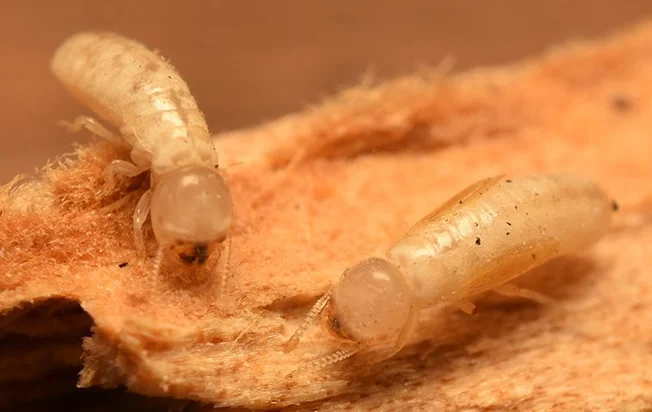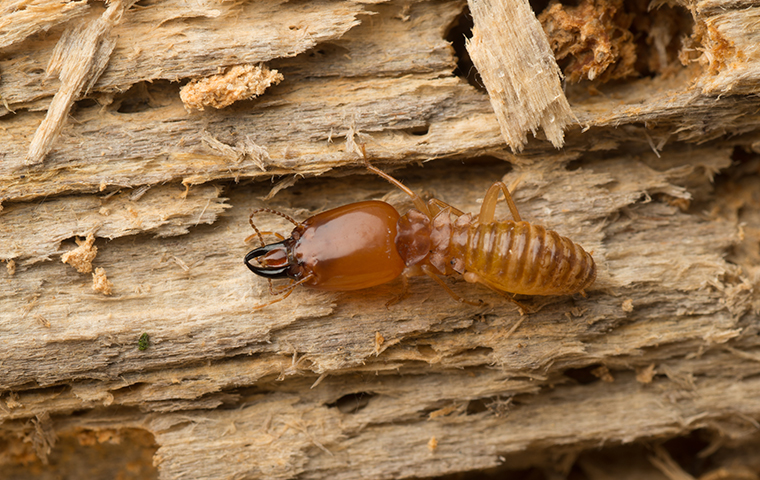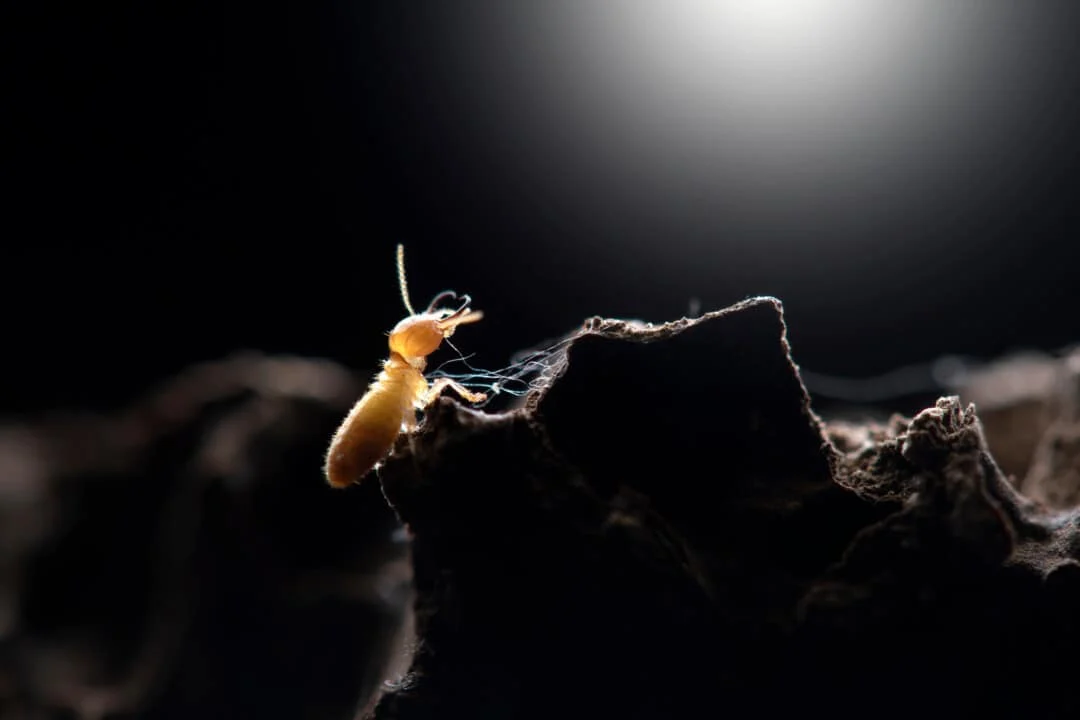Yes, termites are primarily nocturnal insects, meaning they are most active at night. Here are the reasons behind the nocturnal behavior of termites.
- Termites are nocturnal because they reduce the risk of exposure to daytime predators.
- Nocturnal behavior allows termites to avoid drying out in the sun.
- They prefer the darkness for efficient foraging and construction activities.
- Light sensitivity causes termites to retreat quickly when exposed to light, reinforcing their nocturnal habits.
- Some termite species synchronize important activities like swarming and foraging to occur at night.
- It helps them maintain optimal humidity levels.
The Terms “Diurnal” and “Nocturnal”

Before delving into termite behavior, let’s first understand what these terms mean:
A. Diurnal: Diurnal creatures are active during the daytime. They go about their daily activities when the sun is shining and often rest or sleep at night.
B. Nocturnal: Nocturnal creatures are active during the night. They thrive in the darkness, conducting their business under the cover of darkness while sleeping or resting during the day.
Now that we’ve clarified these terms let’s explore the research and findings on termite activity patterns.
Research and Findings on Termite Activity Patterns
Termites are intriguing insects known for their ability to devour wood and cause structural damage to homes. Understanding their activity patterns is essential for effective pest control and management.
Here’s what research has uncovered about termite behavior:
Termite Colonies: Termites live in large colonies, with specific roles assigned to each member. These roles include workers, soldiers, and reproductives (queens and kings). The colony’s daily routine depends on the division of labor among these castes.
Subterranean Termites: Subterranean termites, one of the most common termite species, are known to be primarily nocturnal.
They build intricate tunnels in the ground and emerge at night to forage for food, primarily cellulose-based materials like wood and plant matter.
Drywood Termites: Drywood termites are less strictly nocturnal. Depending on environmental conditions and colony needs, they can be active during both day and night.
Drywood termites don’t come into contact with the soil like subterranean termites do.
Termite Activity Cycles: Termite activity patterns can also vary with seasons. During warmer months, termites tend to be more active, while they slow down during colder periods. However, the intensity of their nocturnal activity remains consistent.
Response to Light: Termites are highly sensitive to light and desiccate quickly when exposed to sunlight. This sensitivity is one reason why they prefer to stay hidden during the day and come out at night when it’s dark.
Swarming Behavior: Termite swarms, which occur when young termites leave the colony to establish new ones, typically happen during the daytime. This is a notable exception to their nocturnal behavior.
Conclusion:
In summary, termites are primarily nocturnal insects, with subterranean termites being more strictly nocturnal than dry-wood termites. Their preference for nighttime activity is driven by their sensitivity to light and the need to avoid desiccation.
Reasons for Nocturnal Behavior
I explored the intriguing world of termite activity patterns in our previous discussion.
Now, let’s dive deeper and uncover the reasons why termites exhibit predominantly nocturnal behavior.
You’ll be amazed by the clever adaptations and survival strategies these insects have developed over millions of years.
A. Adaptation to Predators and Environmental Conditions:
Termites have been around for a very long time, and during their evolution, they’ve faced numerous threats from predators like ants and birds.
To survive, they’ve adapted to avoid these dangers. Being active at night, when many of their predators are less active or asleep, gives termites a significant advantage.
Additionally, termite tunnels and nests are often hidden underground or within wood structures, offering extra protection from potential threats.
This combination of nocturnal habits and concealed habitats helps termites avoid becoming a midnight snack.
B. Protection Against Desiccation:
Termites are highly sensitive to drying out, a condition known as desiccation. Exposure to sunlight and dry air can quickly dehydrate these moisture-loving insects.
That’s why they prefer to stay hidden during the day when the sun is shining and conditions are less humid.
By staying underground or within the protection of their nests during daylight hours, termites can retain the moisture they need to survive. This avoidance of desiccation is a vital part of their nocturnal behavior.
C. Maximizing Efficiency in Resource Acquisition and Construction:
Termites are resourceful insects, constantly on the lookout for food and building materials. Being nocturnal allows them to maximize their efficiency in these activities. Here’s how:
Foraging for Food: Termites feed on cellulose-rich materials like wood.
At night, they can venture out from their nests and forage for these food sources without the risk of drying out or encountering as many predators. This increases their chances of finding sustenance.
Construction Work: Termite colonies are master builders, creating complex tunnel systems and nests. Working in the dark allows them to construct these structures without exposing themselves to potential threats or unfavorable environmental conditions.
Nocturnal Nesting Habits Of Termites
In this segment, I’m going to dive into the world of termite nests and their fascinating architecture. You’ll discover how their nocturnal habits are pivotal in nest construction and maintenance.
A. Description of Termite Nests and Architecture:
Termite nests are remarkable structures, each with its own unique architecture.
These nests serve as the central hub for a termite colony, providing shelter, protection, and a place to raise their young. Here’s a simplified description of termite nests:
Mound Nests: Some termite species, like the well-known African termites, construct towering mound nests that can reach several meters in height.
These mounds consist of a network of tunnels and chambers designed to maintain a controlled temperature and humidity level.
Subterranean Nests: Subterranean termites, common in many parts of the world, build their nests below the ground. These nests consist of intricate tunnel systems that connect to feeding sites and satellite colonies.
Drywood Nests: Drywood termites, as the name suggests, nest within the wood they feed on. They create galleries and chambers within the wooden structures they infest, including furniture and buildings.
B. How Nocturnal Behavior Contributes to Nest Construction and Maintenance:
Termites’ nocturnal behavior plays a crucial role in the construction and maintenance of their nests:
Stealthy Construction: Working under the cover of darkness allows termites to construct and expand their nests without drawing attention.
They can bring building materials, like soil or wood particles, from their foraging expeditions at night, reducing the risk of predators or environmental disruptions.
Temperature Regulation: Nocturnal activity helps termites regulate the nest’s temperature and humidity more effectively.
By avoiding the scorching daytime heat, they can ensure a stable and optimal environment for their colony. This is especially vital for mound nests in regions with extreme climates.
Feeding and Waste Removal: Termites need to maintain a constant supply of food and remove waste from their nests. Their nocturnal foraging allows them to find food sources and discreetly carry them back to the nest.
Likewise, waste materials can be disposed of under the cover of darkness to keep the nest clean and hygienic.
Colony Expansion: When it’s dark, termites can expand their colonies by sending out swarmers to establish new nests. This expansion strategy often occurs during specific seasons, such as spring, to ensure the survival and growth of the colony.
Conclusion:
Termites’ nocturnal nesting habits are a testament to their incredible adaptability and resourcefulness.
Their ability to construct and maintain elaborate nests while avoiding predators and adverse environmental conditions highlights the unique strategies these insects have developed over millions of years.
Communication and Social Structure of Termites

A. Elaboration on Termite Communication Methods:
Termites have evolved fascinating ways to communicate within their colonies. These methods ensure smooth cooperation and division of labor among the different caste members. Here’s a closer look at some of their communication techniques:
Pheromones: Termites release chemical signals called pheromones to convey information. These pheromones can indicate the presence of food, the need for defense, or the existence of potential threats.
Workers lay down pheromone trails to guide others to food sources, helping coordinate foraging efforts.
Vibrations: Termites also communicate through vibrations. By tapping or drumming on surfaces, they create signals that can convey specific messages to colony members.
Vibrations are especially useful in alerting others to danger, such as the presence of predators or disturbances within the nest.
B. How Nocturnal Behavior Supports Social Cohesion and Division of Labor:
Termites’ nocturnal habits are closely tied to their social structure and communication methods:
Reduced Interference: Nocturnal activity reduces interference with external environmental factors and predators, allowing termites to focus on their communication and work within the safety of their nests.
This uninterrupted environment is crucial for effective communication.
Division of Labor: Termites live in highly organized societies with distinct castes, each responsible for specific tasks.
Nocturnal behavior allows these caste members to carry out their duties without disruption efficiently. For example, worker termites can forage for food during the night while soldiers remain on guard to protect the colony.
Nest Maintenance: The maintenance of termite nests is an ongoing process. Nocturnal behavior enables termites to repair and expand their nests while minimizing the risk of exposure to potential threats.
Synchronizing Activities: Many termite activities are synchronized to occur during the night. For instance, reproductive swarmers often take flight at night to establish new colonies. This coordinated timing is essential for the survival and growth of termite colonies.
Conclusion:
Termites’ ability to communicate effectively and maintain their complex social structure is a testament to their evolutionary success.
Their reliance on nocturnal behavior helps them coordinate activities, division of labor, and nest maintenance while minimizing exposure to external threats.
Implications for Pest Control for Termite Infestation
A. Challenges Posed by Nocturnal Termite Behavior in Detection and Eradication:
Dealing with termites can be tricky due to their nocturnal habits. Here are some challenges homeowners and pest control professionals face:
Nighttime Activity: Termites are most active at night, making it hard to spot them during the day. This nocturnal behavior delays the detection of infestations, allowing them to grow undetected.
Hidden Nests: Termites build their nests in hidden places like walls, underground, or deep within structures. Finding and accessing these nests can be tough, especially when they’re active at night.
Light Sensitivity: Termites are sensitive to light. If you shine a light on them, they quickly retreat into their nests or tunnels, making it challenging to observe their behavior.
B. Strategies and Technologies Used to Combat Nocturnal Termite Infestations:
Fortunately, there are effective strategies and technologies to tackle nocturnal termite infestations:
Termite Baiting Systems: Pest control professionals use termite baiting systems that lure termites with enticing baits containing slow-acting insecticides.
These baits are placed strategically and monitored regularly to detect termite activity, taking advantage of their nighttime foraging.
Moisture Control: Termites are sensitive to dry conditions. Managing moisture levels around your home can discourage termites from settling in. Reducing moisture makes your environment less attractive to these pests.
Regular Inspections: Schedule regular inspections by pest control experts. They are trained to spot subtle signs of termite infestations, even if termites are primarily active at night. Early detection is key to minimizing damage.
Infrared Imaging: Advanced infrared imaging technology helps experts detect termite activity by capturing heat signatures. This technology can identify hidden nests and tunnels, even in the dark.
Conclusion:
Termites’ nocturnal behavior can complicate pest control efforts, but you can effectively deal with these elusive pests with the right strategies and technologies.
FAQs
Why are termites active at night?
Termites are sensitive to light and temperature fluctuations, so they forage for food and build their colonies in the dark to avoid exposure to these factors.
Do termites ever come out during the day?
Yes, Termites can occasionally come out during the day, but it’s less common and usually a sign of a severe infestation or disturbance.
What do termites do at night?
At night, termites engage in activities like foraging for cellulose-based food sources (wood, paper, etc.) and maintaining their colonies.
How do termites navigate in the dark?
Termites use pheromones, touch, and smell to communicate and find their way in their dark underground tunnels.
Can I spot termites with a flashlight at night?
No, it’s difficult to spot termites with a flashlight at night as they avoid light sources and are typically active in the dark.
Why don’t termites like light?
Termites avoid light because it can cause them to desiccate or dry out, which is detrimental to their survival.
When is the best time to inspect for termites?
Evening or early morning is ideal for termite inspections as it’s when they are most likely to be active and visible.
Are all termite species nocturnal?
Not all Termite species are nocturnal, but some subterranean termites can be active during the day, especially when high humidity is high.
Conclusion
Termites are primarily active during the night, but their activity can also occur during daylight hours.
Furthermore, the humidity, food availability, and temperature can also affect termites’ nocturnal behavior.
Therefore, it would be more accurate to say that termites can be active both during the day and night.

